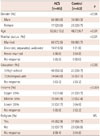1. Mendis S, Puska P, Norrving B. Global atlas on cardiovascular disease prevention and control. . Geneva: World Health Organization;2011.
2. Strike PC, Steptoe A. Psychosocial factors in the development of coronary artery disease. Prog Cardiovasc Dis. 2004; 46:337–347.
3. Lehto S, Koukkunen H, Hintikka J, Viinamäki H, Laakso M, Pyörälä K. Depression after coronary heart disease events. Scand Cardiovasc J. 2000; 34:580–583.
4. Lavie CJ, Milani RV. Prevalence of anxiety in coronary patients with improvement following cardiac rehabilitation and exercise training. Am J Cardiol. 2004; 93:336–339.
5. Barth J, Schumacher M, Herrmann-Lingen C. Depression as a risk factor for mortality in patients with coronary heart disease: a meta-analysis. Psychosom Med. 2004; 66:802–813.
6. Roest AM, Martens EJ, de Jonge P, Denollet J. Anxiety and risk of incident coronary heart disease: a meta-analysis. J Am Coll Cardiol. 2010; 56:38–46.
7. Chida Y, Steptoe A. The association of anger and hostility with future coronary heart disease: a meta-analytic review of prospective evidence. J Am Coll Cardiol. 2009; 53:936–946.
8. Kivimäki M, Virtanen M, Elovainio M, Kouvonen A, Väänänen A, Vahtera J. Work stress in the etiology of coronary heart disease--a meta-analysis. Scand J Work Environ Health. 2006; 32:431–442.
9. Westin L, Carlsson R, Israelsson B, Willenheimer R, Cline C, McNeil TF. Quality of life in patients with ischaemic heart disease: a prospective controlled study. J Intern Med. 1997; 242:239–247.
10. Xie J, Wu EQ, Zheng ZJ, Sullivan PW, Zhan L, Labarthe DR. Patient-reported health status in coronary heart disease in the United States: age, sex, racial, and ethnic differences. Circulation. 2008; 118:491–497.
11. Ryff CD, Dienberg Love G, Urry HL, et al. Psychological well-being and ill-being: do they have distinct or mirrored biological correlates? Psychother Psychosom. 2006; 75:85–95.
12. Huppert FA, Whittington JE. Evidence for the independence of positive and negative well-being: implications for quality of life assessment. Br J Health Psychol. 2003; 8(Pt 1):107–122.
13. Chipperfield JG, Perry RP, Menec VH. Primary and secondary control-enhancing strategies: implications for health in later life. J Aging Health. 1999; 11:517–539.
14. Chipperfield JG, Perry RP. Primary- and secondary-control strategies in later life: predicting hospital outcomes in men and women. Health Psychol. 2006; 25:226–236.
15. Wrosch C, Heckhausen J, Lachman ME. Primary and secondary control strategies for managing health and financial stress across adulthood. Psychol Aging. 2000; 15:387–399.
16. Son C, Na RH. The differences of anger experience, mode of anger expression, and depression in the patients with coronary heart disease and the normal controls. Korean Art Ther Assoc. 2000; 7:87–102.
17. Beck AT, Epstein N, Brown G, Steer RA. An inventory for measuring clinical anxiety: psychometric properties. J Consult Clin Psychol. 1988; 56:893–897.
18. Derogatis LR. SCL-90-R version: manual I. Baltimore, MD: Johns Hopkins University Press;1977.
19. Karasek R, Brisson C, Kawakami N, Houtman I, Bongers P, Amick B. The Job Content Questionnaire (JCQ): an instrument for internationally comparative assessments of psychosocial job characteristics. J Occup Health Psychol. 1998; 3:322–355.
20. Ware JE Jr, Sherbourne CD. The MOS 36-item short-form health survey (SF-36) I Conceptual framework and item selection. Med Care. 1992; 30:473–483.
21. Gwak JH, Lee MK. Relationship of control strategies and subjective well-being: across young·middle·old adulthood. J Korean Gerontol Soc. 2006; 26:565–580.
22. Smith TW, Ruiz JM. Psychosocial influences on the development and course of coronary heart disease: current status and implications for research and practice. J Consult Clin Psychol. 2002; 70:548–568.
23. Rumsfeld JS, MaWhinney S, McCarthy M Jr, et al. Participants of the Department of Veterans Affairs Cooperative Study Group on Processes, Structures, and Outcomes of Care in Cardiac Surgery. Health-related quality of life as a predictor of mortality following coronary artery bypass graft surgery. JAMA. 1999; 281:1298–1303.
24. Westin L, Nilstun T, Carlsson R, Erhardt L. Patients with ischemic heart disease: quality of life predicts long-term mortality. Scand Cardiovasc J. 2005; 39:50–54.
25. Weisz JR, Rothbaum FM, Blackburn TC. Standing out and standing in: the psychology of control in America and Japan. Am Psychol. 1984; 39:955–969.
26. Siegman AW, Townsend ST, Civelek AC, Blumenthal RS. Antagonistic behavior, dominance, hostility, and coronary heart disease. Psychosom Med. 2000; 62:248–257.
27. Kawachi I, Sparrow D, Vokonas PS, Weiss ST. Symptoms of anxiety and risk of coronary heart disease. The Normative Aging Study. Circulation. 1994; 90:2225–2229.
28. Rozanski A, Blumenthal JA, Kaplan J. Impact of psychological factors on the pathogenesis of cardiovascular disease and implications for therapy. Circulation. 1999; 99:2192–2217.
29. Backé EM, Seidler A, Latza U, Rossnagel K, Schumann B. The role of psychosocial stress at work for the development of cardiovascular diseases: a systematic review. Int Arch Occup Environ Health. 2012; 85:67–79.
30. An K, De Jong MJ, Riegel BJ, et al. A cross-sectional examination of changes in anxiety early after acute myocardial infarction. Heart Lung. 2004; 33:75–82.










 PDF
PDF ePub
ePub Citation
Citation Print
Print


 XML Download
XML Download